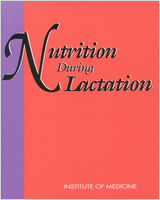From: 9, Meeting Maternal Nutrient Needs During Lactation

Nutrition During Lactation.
Institute of Medicine (US) Committee on Nutritional Status During Pregnancy and Lactation.
Washington (DC): National Academies Press (US); 1991.
Copyright © 1991 by the National Academy of Sciences.
NCBI Bookshelf. A service of the National Library of Medicine, National Institutes of Health.